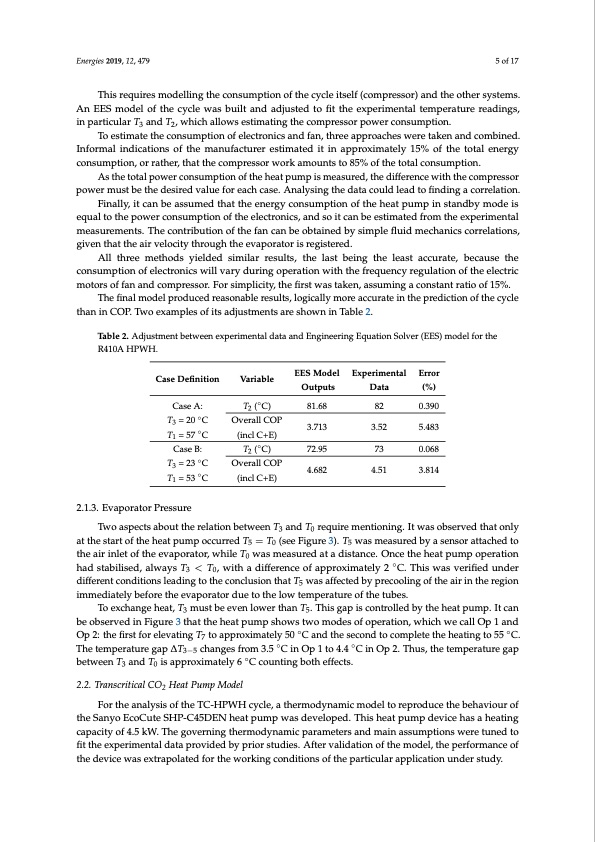
PDF Publication Title:
Text from PDF Page: 005
Energies 2019, 12, 479 5 of 17 This requires modelling the consumption of the cycle itself (compressor) and the other systems. An EES model of the cycle was built and adjusted to fit the experimental temperature readings, in particular T3 and T2, which allows estimating the compressor power consumption. To estimate the consumption of electronics and fan, three approaches were taken and combined. Informal indications of the manufacturer estimated it in approximately 15% of the total energy consumption, or rather, that the compressor work amounts to 85% of the total consumption. As the total power consumption of the heat pump is measured, the difference with the compressor power must be the desired value for each case. Analysing the data could lead to finding a correlation. Finally, it can be assumed that the energy consumption of the heat pump in standby mode is equal to the power consumption of the electronics, and so it can be estimated from the experimental measurements. The contribution of the fan can be obtained by simple fluid mechanics correlations, given that the air velocity through the evaporator is registered. All three methods yielded similar results, the last being the least accurate, because the consumption of electronics will vary during operation with the frequency regulation of the electric motors of fan and compressor. For simplicity, the first was taken, assuming a constant ratio of 15%. The final model produced reasonable results, logically more accurate in the prediction of the cycle than in COP. Two examples of its adjustments are shown in Table 2. Table 2. Adjustment between experimental data and Engineering Equation Solver (EES) model for the R410A HPWH. Case Definition Case A: T3 = 20 ◦C T1 = 57 ◦C Case B: T3 = 23 ◦C T1 = 53 ◦C 2.1.3. Evaporator Pressure Variable T2 (◦C) Overall COP (incl C+E) T2 (◦C) Overall COP (incl C+E) EES Model Experimental Outputs Data 81.68 82 3.713 3.52 72.95 73 4.682 4.51 Error (%) 0.390 5.483 0.068 3.814 Two aspects about the relation between T3 and T0 require mentioning. It was observed that only at the start of the heat pump occurred T5 = T0 (see Figure 3). T5 was measured by a sensor attached to the air inlet of the evaporator, while T0 was measured at a distance. Once the heat pump operation had stabilised, always T3 < T0, with a difference of approximately 2 ◦C. This was verified under different conditions leading to the conclusion that T5 was affected by precooling of the air in the region immediately before the evaporator due to the low temperature of the tubes. To exchange heat, T3 must be even lower than T5. This gap is controlled by the heat pump. It can be observed in Figure 3 that the heat pump shows two modes of operation, which we call Op 1 and Op 2: the first for elevating T7 to approximately 50 ◦C and the second to complete the heating to 55 ◦C. The temperature gap ∆T3−5 changes from 3.5 ◦C in Op 1 to 4.4 ◦C in Op 2. Thus, the temperature gap between T3 and T0 is approximately 6 ◦C counting both effects. 2.2. Transcritical CO2 Heat Pump Model For the analysis of the TC-HPWH cycle, a thermodynamic model to reproduce the behaviour of the Sanyo EcoCute SHP-C45DEN heat pump was developed. This heat pump device has a heating capacity of 4.5 kW. The governing thermodynamic parameters and main assumptions were tuned to fit the experimental data provided by prior studies. After validation of the model, the performance of the device was extrapolated for the working conditions of the particular application under study.PDF Image | Comparison of Transcritical CO2 and Conventional Refrigerant Heat Pump

PDF Search Title:
Comparison of Transcritical CO2 and Conventional Refrigerant Heat PumpOriginal File Name Searched:
energies-12-00479.pdfDIY PDF Search: Google It | Yahoo | Bing
CO2 Organic Rankine Cycle Experimenter Platform The supercritical CO2 phase change system is both a heat pump and organic rankine cycle which can be used for those purposes and as a supercritical extractor for advanced subcritical and supercritical extraction technology. Uses include producing nanoparticles, precious metal CO2 extraction, lithium battery recycling, and other applications... More Info
Heat Pumps CO2 ORC Heat Pump System Platform More Info
| CONTACT TEL: 608-238-6001 Email: greg@infinityturbine.com | RSS | AMP |